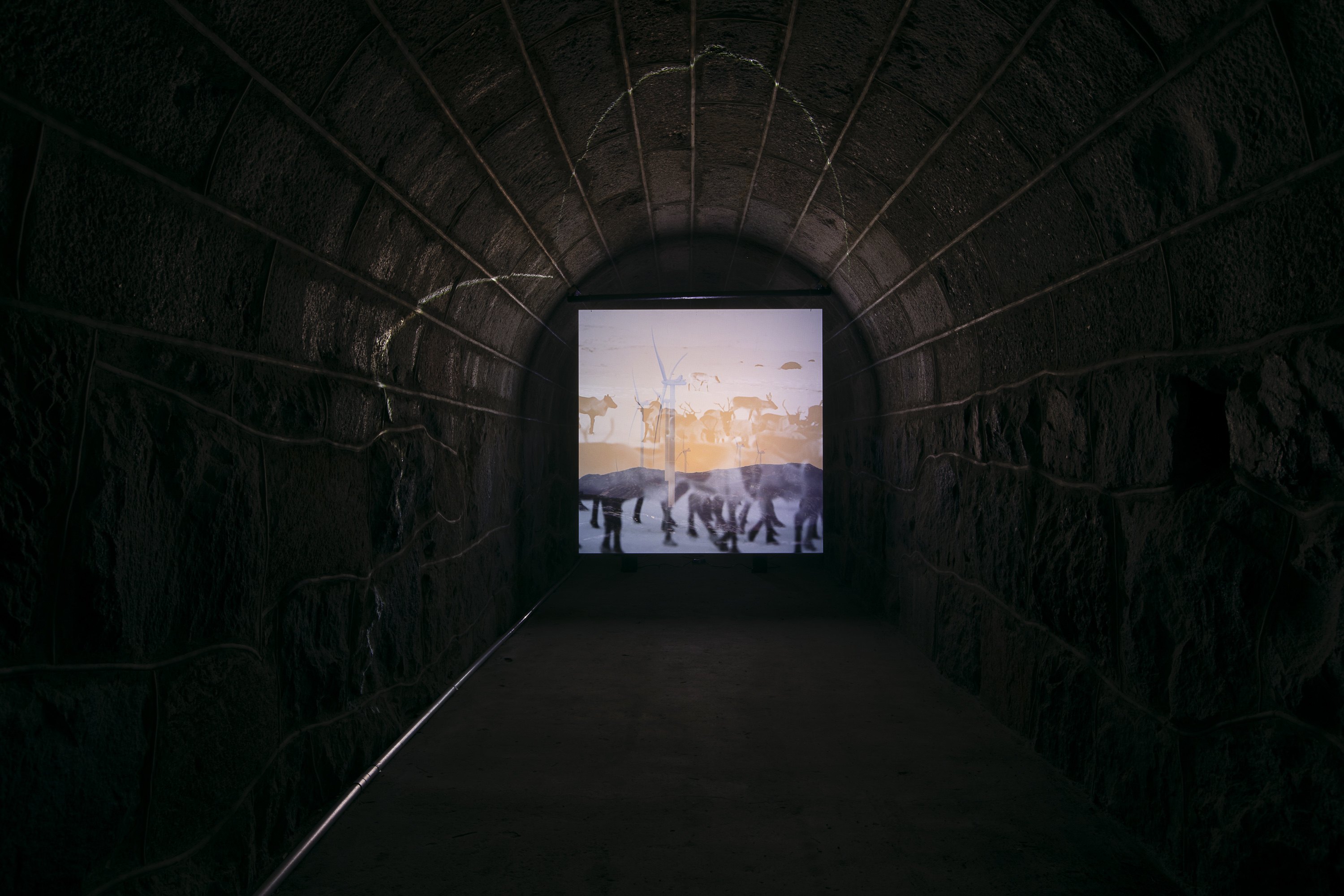Matti Aikio is a Sámi artist with roots in reindeer herding. He explores the intersection of modern Western society and indigenous cultures, their relative worldviews and conceptions of space and time, with a particular interest in the conflict between their use of natural resources, arising from their fundamentally different approaches to nature. Combining moving image, sound, text, and photography, Aikio raises issues about the Sámi truth and the reconciliation process, cultural appropriation and Sámi self-determination.
Aikio’s new work for Helsinki Biennial 2023 was a video and sound installation located inside one of the old gunpowder magazines on Vallisaari Island. The work is informed by his cultural background and lived experience, and it addresses conflicts around the use of natural resources, nature conservation, fossil-free energy production and more broadly human relations with other living beings. Understanding nature as something outside or external to the human realm, as an object of extraction or conservation, is revealed as a blind spot that inevitably affects the way nature is understood and treated.
I recall when I was young, I was told an anecdote about the Finnish sociologist Erik Allardt. As I remember it, he said, in the 1990s, that the conflict between the Sámi people and the Finnish nation state signifies that the Sámi people have not yet been fully assimilated. The assimilation process is not yet finalized. I find this to be an interesting interpretation of the conflict. It makes me think that conflict can be a positive sign. A conflict can mean that an indigenous group is still indigenous.
My Sámi family history is a history of conflict. I carry a trauma inherited from my great-great-grandfather, whose first wife died in prison in the aftermath of the Kautokeino rebellion of 1852. Just shortly prior to the rebellion, the border between Norway and Finland had been closed, blocking the seasonal migration of the nomadic Sámi reindeer herders. The closure of the border was partly prompted by complaints from Finnish settlers who had settled on Sámi lands near the Norwegian border.
My grandfather tried to protect his reindeer grazing lands against the forest industry and hydropower plants.
Modern society’s relationship with nature is schizophrenic. We try to solve massive problems caused by old human technology with new human technology. But we seem to be blind to the fact that there are not enough minerals for even one generation of electric cars on a global scale. Modern society is destroying ecosystems on indigenous lands for the sake of economic gains and fossil free energy. The very same modern society wants to strictly protect certain symbolic species like wolves or wolverines as proof that there is still wild nature left after all this industrial exploitation.
Matti Aikio

Matti Aikio, Oikos, 2023, Helsinki Biennial 12.6.-17.9.2023, Vallisaari, Helsinki, Photo: © HAM/Helsinki Biennial/Kirsi Halkola
Co-Commissioned by Helsinki Biennial and TBA21–Academy, produced by HAM Helsinki Art Museum/Helsinki Biennial 2023.
Aikio’s works have recently been on display in the following exhibitions: Unfinished Histories, Botkyrka Konsthall, Stockholm (2022); Mäccmõš, maccâm, máhccan – The Homecoming, National Museum of Finland, Helsinki (2021–2022); and Nils-Aslak Valkeapää – Áillohaš, Henie Onstad Kunstsenter, Oslo (2020–2021).
Aikio is one of the TBA21-Academy’s Ocean Fellows 2022 and the Sámi Fellow at the Vera List Center for Art and Politics 2022–2023.
Matti Aikio
Oikos
2023
video and sound installation
Sound: Miro Mantere
Joik: Niko Valkeapää
Thank you: Kone Foundation
Co-Commissioned by Helsinki Biennial and TBA21–Academy, produced by HAM Helsinki Art Museum/Helsinki Biennial 2023